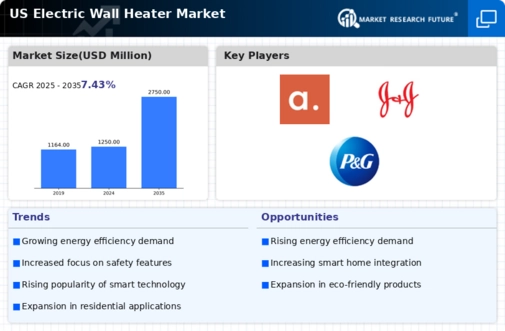Growing Awareness of Indoor Air Quality
The electric wall-heater market is influenced by a growing awareness of indoor air quality among consumers. Traditional heating systems can contribute to poor air quality due to dust and allergens being circulated throughout the home. Electric wall heaters, on the other hand, provide a cleaner heating option that does not rely on combustion, thereby reducing the risk of indoor air pollutants. This shift in consumer preference is prompting manufacturers to highlight the health benefits of electric wall heaters. The electric wall-heater market is thus positioned to grow as more individuals prioritize their health and well-being, seeking heating solutions that promote a healthier living environment.
Technological Advancements in Heating Systems
The electric wall-heater market is witnessing rapid technological advancements that enhance the functionality and efficiency of heating systems. Innovations such as smart thermostats, remote control capabilities, and integration with home automation systems are becoming increasingly prevalent. These advancements not only improve user convenience but also optimize energy usage, which is a critical factor for many consumers. The electric wall-heater market is adapting to these changes, with manufacturers investing in research and development to create products that incorporate the latest technologies. As a result, the market is likely to expand as consumers seek out modern heating solutions that offer both comfort and efficiency.
Increased Focus on Home Renovations and Upgrades
The electric wall-heater market is benefiting from a surge in home renovations and upgrades across the United States. Homeowners are increasingly investing in modernizing their living spaces, which includes upgrading heating systems. This trend is driven by the desire for improved comfort, aesthetics, and energy efficiency. The National Association of Home Builders reports that home improvement spending has risen significantly, with a projected increase of 10% in 2025. As part of these renovations, electric wall heaters are often chosen for their space-saving designs and ease of installation. Consequently, the electric wall-heater market is likely to see sustained growth as more homeowners opt for these efficient heating solutions during their renovation projects.
Regulatory Support for Energy-Efficient Products
The electric wall-heater market is supported by regulatory initiatives aimed at promoting energy-efficient products. Government policies and incentives encourage consumers to adopt energy-saving technologies, which include electric wall heaters. Programs such as tax credits and rebates for energy-efficient home improvements are becoming more common, making these products more financially accessible. The electric wall-heater market stands to benefit from these regulatory frameworks, as they not only stimulate demand but also foster innovation among manufacturers. As regulations continue to evolve, the market is likely to see an increase in the adoption of electric wall heaters, aligning with broader energy conservation goals.
Rising Demand for Energy-Efficient Heating Solutions
The electric wall-heater market is experiencing a notable increase in demand for energy-efficient heating solutions. As consumers become more environmentally conscious, they are seeking products that minimize energy consumption while providing effective heating. This trend is reflected in the growing popularity of electric wall heaters, which often feature advanced insulation and energy-saving technologies. According to recent data, energy-efficient heating solutions can reduce energy costs by up to 30%, making them an attractive option for homeowners. The electric wall-heater market is thus poised for growth as manufacturers innovate to meet these demands, offering products that align with sustainability goals and energy regulations.














Leave a Comment